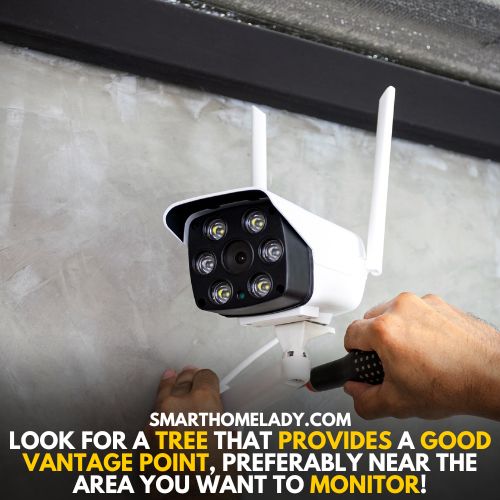Are you considering installing security cameras on your property but wondering if it’s possible to mount them on trees?
In this comprehensive article, I’ll tell you in detail about “Can you put security cameras on trees or not?”
I’ll also cover how to hide security cameras in trees, and whether popular camera brands like Ring and Blink are compatible with this mounting option.
So, let’s dive into the details and explore the world of security cameras on trees.

Contents
- 1 Can you attach a security camera to a tree?
- 2 How do you strap a camera to a tree? Recommendations & Considerations
- 3 How do you hide security cameras in a tree? 4 Tips
- 4 Can I mount a ring camera to a tree?
- 5 Can you put a Blink camera on a tree?
- 6 How to mount security camera to tree – 4 Easy Steps
- 7 Where Not To Place Security Cameras?
- 8 Can you mount a nest camera on a tree?
- 9 Do burglars avoid houses with cameras?
- 10 Is it legal to put cameras around your house?
- 11 Conclusion
Can you attach a security camera to a tree?
The answer is yes, you absolutely can. In fact, attaching security cameras to trees provides a number of advantages such as wider coverage and natural camouflage. However, it also has a few disadvantages too.
Attaching a security camera to a tree can be an effective way to monitor outdoor spaces. There are various strapping techniques and alternative mounting options available that make it possible to secure the camera firmly onto the trunk or branches of a tree.
Additionally, there are tree-friendly camera models specifically designed for this purpose, which minimize any potential damage to the tree.
If you prefer a more DIY approach, you can also utilize camouflage methods to blend the camera with its surroundings, making it less noticeable.
Pros And Cons Of Tree-Mounted Cameras
| Pros | Cons |
|---|---|
| Elevated position for better surveillance coverage | Swinging in strong winds |
| Difficult to tamper with or disable | Obstruction from branch movements |
| Natural camouflage for discreet monitoring | Installation risks |
| Limited control over camera positioning | |
| Vulnerability to wildlife interference |
It’s crucial to carefully weigh these factors before deciding whether attaching a security camera to a tree is the right choice for your specific needs.
How do you strap a camera to a tree? Recommendations & Considerations
To securely mount a camera on a tree, fastening it with sturdy straps or harnesses is recommended. There are various mounting techniques available to ensure the camera stays in place and captures clear footage.
When choosing straps or harnesses, opt for ones that are weatherproof and durable to withstand outdoor elements.
Additionally, consider using tree-friendly mounting accessories such as rubberized clamps or adjustable brackets to avoid damaging the tree bark.
To achieve the desired camera angle, position the camera at a height where it can capture a wide field of view without obstruction.
It is also crucial to select weatherproofing options for the camera itself, such as waterproof housing or protective covers, to safeguard it from rain, dust, and other environmental factors.
If strapping directly onto a tree is not feasible, alternative mounting options include using poles or tripod stands nearby.
Ultimately, by following these recommendations and considering important factors like mounting techniques and weatherproofing options, you can effectively secure a security camera to a tree while ensuring optimal performance and longevity.
| Mounting Techniques | Weatherproofing Options | Recommended Camera Angles |
|---|---|---|
| Sturdy straps | Waterproof housing | Wide field of view |
| Harnesses | Protective covers | Clear line of sight |
| Adjustable brackets | Dust-proof casing | Elevated position |
How do you hide security cameras in a tree? 4 Tips
For a hidden approach, consider concealing your security cameras within the branches of a tree using camouflage techniques.
1. Creative Camouflage
Creative camouflage is key to hiding security cameras in plain sight and making them blend seamlessly with their surroundings.
You can use materials such as bark or foliage to cover the camera housing and make it appear like a natural part of the tree.
2. Alternative Mounting Options
Alternative mounting options can be explored by using other natural elements like vines or branches to securely attach the cameras to trees without causing any damage.
Wireless solutions are also available for tree-mounted security cameras, eliminating the need for wiring and making installation easier.

3. Choosing Weatherproof Housing For Cameras
When mounting cameras on trees, it is important to weatherproof them properly so they can withstand outdoor conditions such as rain, wind, and extreme temperatures.
It includes choosing waterproof housings and sealing any exposed connections.
4. Select The Right Type Of Tree
Lastly, selecting the right type of tree is crucial for proper camera placement.
Look for trees that have dense foliage or branches that provide good coverage and concealment while still allowing an unobstructed view for capturing surveillance footage effectively.
By following these tips, you can successfully hide security cameras in trees while maintaining optimal functionality and ensuring your property remains secure.
Can I mount a ring camera to a tree?
According to the Ring community, it is not recommended to mount a ring camera to a tree.
Mounting a Ring camera to a tree is possible by utilizing alternative mounting options and creative camouflage techniques.
When considering mounting options, it’s important to choose a sturdy and secure mount that can withstand outdoor conditions.
There are various mounts available in the market specifically designed for tree installation, such as adjustable straps or brackets that wrap around the trunk. These mounts allow you to securely attach the Ring camera to the tree without causing any damage.
Can you put a Blink camera on a tree?
Yes, it is indeed possible to mount a Blink camera on a tree. The Blink XT, which is specifically designed for outdoor use, offers weatherproof capabilities, making it suitable for such placements.
With a 110-degree field of view, infrared night vision, and the ability to save motion-activated video clips to the cloud, the Blink camera provides reliable surveillance.
- To mount the camera on a tree, it is recommended to use the included mounting bracket and secure it with zip ties or other fasteners.
- Choosing a suitable location on the tree that offers a good vantage point and covers the desired surveillance area is crucial.
- Ensuring stability by securely mounting the camera will prevent it from falling or being disturbed by branches or animals.
- It is also essential to consider the power source, especially if the tree is far from an electrical outlet. In such cases, the battery-powered Blink XT2 with its long battery life can be a suitable option.
- Alternatively, a solar panel add-on can be used to recharge the camera’s battery.
- However, it is important to be mindful of local regulations and ensure compliance with any rules or restrictions regarding camera placement.
How to mount security camera to tree – 4 Easy Steps
Mounting a security camera to the tree is easy and you can do this by following these 4 steps.
Step 1 – Choose the right security camera and mounting equipment
The first step to mounting a security camera on a tree is to select the appropriate camera and mounting equipment. Look for a camera specifically designed for outdoor use with weatherproof features.
Ensure it has a wide field of view and high-resolution capabilities to capture clear footage.
Additionally, choose a mounting bracket or tree strap that is sturdy and adjustable, allowing you to position the camera at the desired angle.
Step 2 – Find the perfect tree and location
Once you have the necessary equipment, it’s time to find the ideal tree and location for your security camera. Look for a tree that provides a good vantage point, preferably near the area you want to monitor.
Make sure the tree is sturdy and can support the weight of the camera.
It’s important to select a location that offers a clear line of sight and minimizes obstructions such as branches or foliage that could obstruct the camera’s view.

Step 3 – Attach the mounting bracket or tree strap
Next, securely attach the mounting bracket or tree strap to the tree trunk. If using a mounting bracket, position it at a height and angle that provides the best coverage.
Ensure the bracket is tightly fastened to the tree using screws or straps, depending on the design.
If using a tree strap, wrap it around the tree and tighten it to prevent any movement or slippage.
Step 4: Mount the security camera
Once the mounting bracket or tree strap is securely in place, it’s time to mount the security camera.
Carefully attach the camera to the bracket or strap, ensuring it is stable and level. Make any necessary adjustments to the camera’s position and angle to achieve the desired field of view.
Double-check the mounting to ensure it is secure and won’t be easily tampered with or affected by wind or weather conditions.
Remember – Regularly check and maintain the camera to ensure its functionality and longevity.
Frequently Asked Questions FAQs
Where Not To Place Security Cameras?
When it comes to placing security cameras, it’s important to be strategic to ensure optimal surveillance coverage.
There are a few spots you should avoid when it comes to camera placement.
Firstly, it’s not advisable to position cameras in bathrooms, bedrooms, or any other private areas where people have a reasonable expectation of privacy.
Placing cameras in such areas can infringe upon personal privacy rights and may even be illegal in some jurisdictions.
Additionally, avoid pointing cameras directly at your neighbor’s property as this can cause unnecessary tension and may also be a violation of privacy laws.
Can you mount a nest camera on a tree?
Yes, you can definitely mount a Nest camera on a tree. In fact, mounting a camera on a tree can be a clever and effective way to monitor certain areas of your property.
Just make sure to choose a location where the tree provides an unobstructed view of the desired surveillance area.
Take into consideration factors such as the camera’s field of view, the height of the tree, and the stability of the mounting surface.
Ensure that the camera is securely attached to the tree trunk using appropriate mounting hardware to prevent it from falling or being easily tampered with.
Do burglars avoid houses with cameras?
Yes, studies and anecdotal evidence suggest that burglars tend to avoid houses with visible security cameras.
The presence of cameras acts as a deterrent, making potential intruders think twice before attempting to break into a property.
Burglars are more likely to target homes with minimal or no security measures in place, as they prefer to avoid the risk of getting caught on camera.
However, it’s important to note that determined criminals may still attempt to disable or avoid cameras by wearing disguises or covering their faces.
Therefore, it’s always a good idea to complement your camera system with other security measures like alarms and motion sensor lighting for enhanced protection.
Is it legal to put cameras around your house?
In general, it is legal to install security cameras around your house, as long as you adhere to certain guidelines and respect the privacy of others.
Laws regarding surveillance can vary depending on your jurisdiction, so it’s essential to familiarize yourself with local regulations.
Generally, it is recommended to avoid recording areas where people have a reasonable expectation of privacy, such as inside their homes and in certain public spaces.
It’s advisable to consult local laws and regulations, and when in doubt, seek legal advice to ensure you are in compliance with all applicable laws.
Conclusion
In conclusion, securing your property with security cameras attached to trees is indeed feasible and offers numerous advantages in terms of surveillance.
By following proper installation techniques and utilizing specialized mounting accessories, you can ensure stable positioning and efficient monitoring capabilities.
So go ahead and explore this option as part of your overall security strategy—it’s worth considering.


